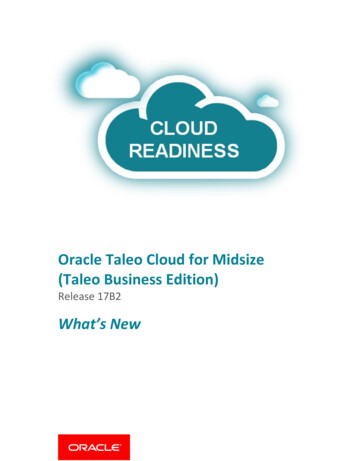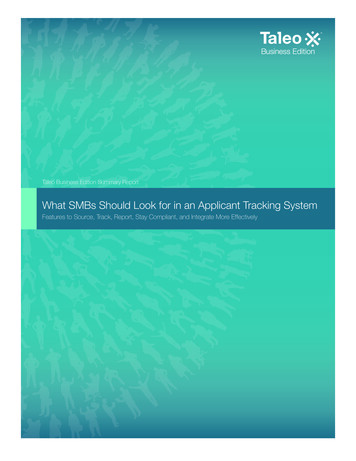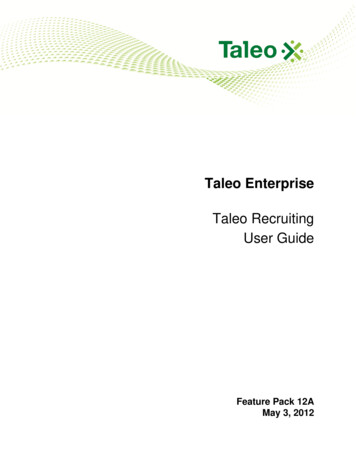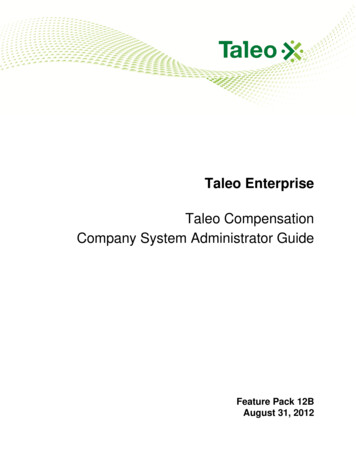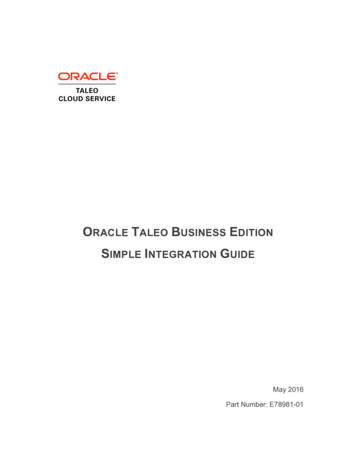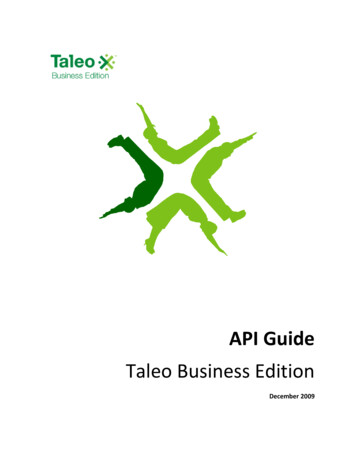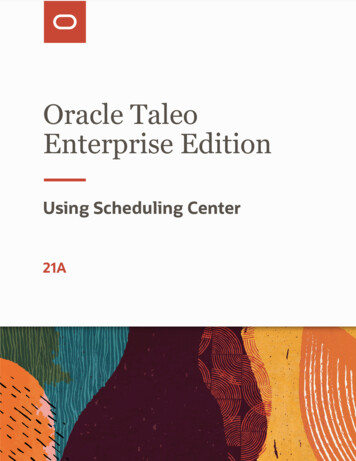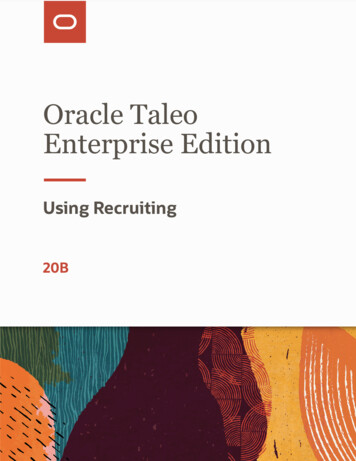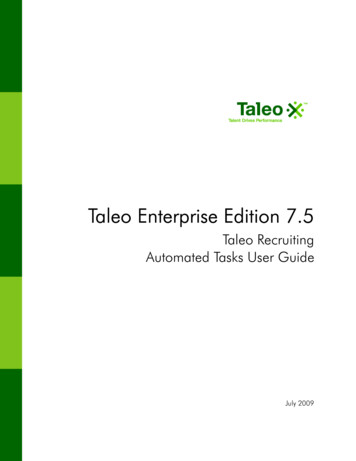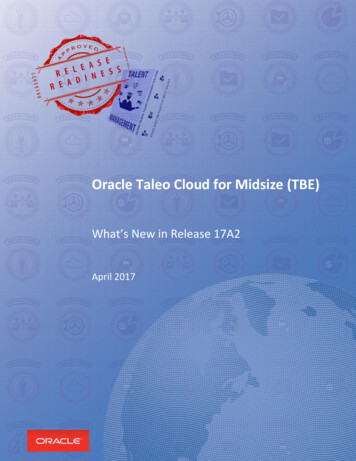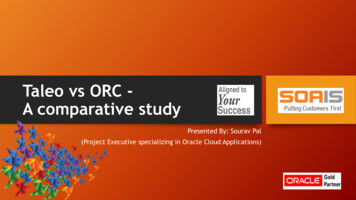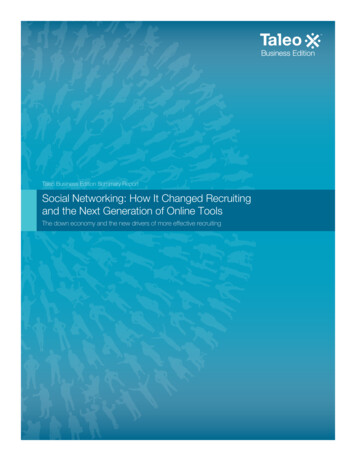
Transcription
Taleo Business Edition Summary ReportSocial Networking: How It Changed Recruitingand the Next Generation of Online ToolsThe down economy and the new drivers of more effective recruiting
Social Networking: How It ChangedRecruiting and the Next Generation ofOnline ToolsUsing new technologies to navigatea complex recruiting environmentFor recruiters, the talent acquisition environment in2009 is strikingly different and more difficult thanin previous years. With 2008 ending as the worstyear for layoffs in the U.S. since the end of WorldWar Two and unemployment rates increasing to 8.5percent in March 2009, 13.2 million people are nowlooking for jobs.Most of these unemployed are turning to online jobboard and career sites that make it easy to applyfor any position that seems like even a remote fit.As a result, finding top talent in a market floodedwith unqualified candidates has become muchmore difficult.To find the best candidates among active andpassive job seekers, more recruiters are turningto free social networking technology as anincreasingly attractive alternative to paid jobboards. Whether the economy is up or down, theability to source candidates on social networkswill be essential for recruiters in the coming years.These mostly free technologies can provide apowerful advantage to find qualified candidates inspecific locations with specific skills and training.However, recruiters must understand how thedifferent applications work and the audiences thesesites, applications and networks attract.Recruiters who wish to succeed must become moreadept at using social networking and other Web 2.0technologies to find the best candidates. This paperprovides an overview of current technologiesand websites, and offers recommendations aboutincorporating them into daily practice.Web 2.0 technologies continue rapid growthAnyone who wants to understand how to bestreach the best candidates in the current economymust first understand how Internet usage haschanged over the past several years. Over the pastseveral years, the exponential growth of socialnetworks, blogs and Web 2.0 technologies havechanged what is possible in the world of recruiting.MySpace , Facebook , LinkedIn and other sitesoffer people with common interests a place togather and share contacts, opinions, experiences,and increasingly, job opportunities. The numbersare staggering: LinkedIn has approximately 36 millionmembers – more than half located in the U.S. Facebook has more than 175 million members,and about 30 percent of them – more than 50million – are in the U.S. Twitter has more than 11 million users andattracted 7 million unique users in February – a1,382 percent growth since last year.1These innovative web solutions have also beena result of larger changes in the use of the Web,thanks to increased broadband access and cheaperdata storage. According to Nielsen/Net Ratings,more than 72 percent of the U.S. population usesthe Internet, but it is even more revealing whatthey are doing online. According to Forrester’sNorth American Media & Marketing Online Surveydone in Q2, 2008, 29 percent of adults between25 and 34 years old create online content such asblogs, upload videos, and publish web pages ona monthly basis, and 42 percent post ratings orreviews of products and services online, commenton someone else’s blogs, or use other means tocritic already existing online content.1 Leberecht, Tim. SXSW thoughts on Twitter’s past, present, future. CNETNews. March 22, 2009. http://news.cnet.com/8301-13641 3-1020171344.htmlPAGE 1Social Networking Copyright 2009 Taleo Corporation
Expect these numbers to grow as mediaconsumption habits continue to change. Accordingto recent research from eMarketer2, Web 2.0technologies are among the fastest growing mediasources: Blogs are now used by 24 percent of Internetusers, up from 13 percent in 2006. Social networks are now used by 26 percent ofInternet users, up from 17 percent in 2006. Videocasts are now used by 11 percent ofInternet users, up from 6 percent in 2006.similar networks are available such as Plaxo ,Ecademy and Ryze , and other sites that offeraccess to niches or better manage their networkscontinue to come online, including: Doostang is similar to LinkedIn but a goodsource for candidates from exclusive topschools and recently graduated candidates. Naymz aims to simplify the process ofmanaging and building an online professionalnetwork. AffinityCircles is social networking formember-based online communities, such asalumni associations. Xing , Viadeo and Tianji provide access tointernational professional networks. Vault is a network made of user generatedcontent that provides great insight intocompany’s business in formation, culture andsuch that can help with finding new job ordersand/or candidates. School and corporate alumni networks can alsooffer goldmine of candidates and information.Social networking is still the future of recruitingJob opportunities, like any other content of interestfor members of social and professional networksare being shared and tagged everyday. Althoughrecruiters have been one of the first professionalgroups to embrace these online networks to source,screen and know more about potential candidates,today that advantage is shrinking and will be gonesoon as more and more recruiters are using thesetools.The next generation recruiters must not onlybe aware of these online tools but also havea profound knowledge on how to maximizethe value from them. They also need tobe continuously watching new tools andexperimenting with them.“I’ll be stunned if 20-50 percent of candidatereferrals aren’t coming through online communitiesin five or six years” says Jason Blessing of Taleo,a leading eRecruiting software company. Blessingsays that while referrals and networking havealways been the most effective techniques to sourcequality candidates, over the last couple of years,many of these efforts have gone virtual throughboth employee referrals and professional networks.Even though most recruiters are already awareof the benefits of social networks geared towardprofessionals such as LinkedIn, a number of other Copyright 2009 Taleo CorporationAlthough recruiters can use many of thesenetworks to build extensive contact lists to sourcecandidates better, LinkedIn is still the leaderbecause of its size and integration with other usefulapplications, including: SimplyHired allows recruiters to search forjobs posted on LinkedIn and also on other jobboards. Six Apart is blogging software that allowsusers to connect a blog to a LinkedIn profileand pull in the latest blog posts from the user’snetwork.2 Traditional Media Use Stabilizes as Online Rises. eMarketer.com. January 29,2009. http://www.emarketer.com/Article.aspx?id 1006892Social NetworkingPAGE 2
Twitter allows users to track what is writtenabout your company on a real-time basis withLinkedIn’s “Company Buzz” application.Wordpress is blogging software that can besynced with a LinkedIn profile.Don’t overlook the power of bloggingAlthough more recruiters are choosing to buildtheir personal brand through blogging, even thosewho don’t can use the power of the blogosphereto source candidates and job opportunities usingthese sites. Twitter is an often misunderstood site, butcan be quite valuable to recruiters. With a postlimit of 140 characters, this microblogging siteis a must for recruiters who want to network,engage and market themselves.3 Using thesearch tool, recruiters can source candidatesand also find job opportunities. However, usea hash tag (#) before a word in a post to tag itand make the content searchable. Technorati , Blog Catalog and Google BlogSearch can help you identify and searchrelevant blogs that can yield talented passivecandidates among those who blog andcomment. Friendfeed , Digg , del.icio.us and othercontent sharing sites can offer channels tomaintain relationships with candidates4 andeven source talent.5Passive candidates still matterIn a job market flooded with active candidates,passive candidates still matter because much ofthe best available talent for any position is stillemployed. However, as these workers are beingasked to do more to compensate for jobs cuts anda slow economy, they may be interested in a betteroffer if you can develop a relationship with them.The personal aspect of social networking isone reason that draws many human resourcesprofessionals to sites like Friendster and Facebook.Of Facebook, Blessing says, “It’s much more aboutsharing preferences and experiences and buildinga community of friends. All of the applications thathave sprung up on Facebook really perpetuate thatculture.”He says this makes Facebook and some ofthe other social utilities such great places foremployers to source candidates, and why hiscompany makes software that helps Facebookusers share job openings with their friends. Oftenthe friend noticing the job posting isn’t activelylooking to change jobs, but can be enticed by theright opportunity and by the knowledge that it’stheir friend who is making the recommendation.Blessing says it is these passive candidates thatemployers have to tap into, especially during atight labor market where everyone is chasing afinite number of candidates. “Passive doesn’t meanuninterested,” he points out.3 Meher, Jessica. Why Recruiters Should Use Twitter and Must-Know Tips forFinding New Talent and Business. RecruitingBlogs.com. December 9, gs/why-recruiters-should-use4 Peterson, Geoff. Add FriendFeed to Your Bag of Tricks. ERE.net. July 21,2008. ur-bag-of-tricks/5 Stroud, Jim. How to find passive candidates with Digg. The RecruitersLounge. February 25, 2008. to-find-passive-candidates-with-digg/PAGE 3Social Networking Copyright 2009 Taleo Corporation
Although social networks can be useful, recruitersshould be aware of a network’s audience and howit can be useful: -Bebo has sites around the globe,including the U.S., U.K., Ireland, Australia,New Zealand, Canada, Poland, France,Germany, Italy, Spain, India and theNetherlands.-Orkut , which is owned by Google, is anetwork especially popular in Brazil andIndia.-Wasabi is a European-centered socialnetwork with sites for the U.K., France,Germany, Italy and Spain.-Mixi is a Japanese-language site withover 10 million users and a 90 percentshare of the social networking market inJapan.MiGente is social network geared toward thisHispanic community in the U.S.-MeetUp is good tool to use as a backdoorto find people that are part of certain affinitygroups. Because users must meet certaincriteria to qualify and join, recruiters can’t getcontact info, but can glean information andeventually learn qualified names that later canbe profiled for contact information.Kiaxin means “fun” and “happiness”in Chinese and is a fast-growing socialnetwork in China that attracts collegestudents and white-collar workers.Hainei and Xiaonei are Chinesesocial networks with more of a focus oncollege-students.-CyWorld has large numbers of users inKorea, China, Japan and Taiwan.Facebook is a good tool to find candidatesusing affinity groups as well as learn moreabout a candidate’s personal life. With morethan 175 million active users, more than halfof its users are now outside of college, thenetwork’s fastest growing demographic isthose 35 and older.MySpace has 185 million users with a primarydemographic between 14 and 34, and isconsidered a good site for recruiters to findcandidates for the retail industry, the armedservices and for entry-level positions.The growing number of internationalnetworks with large numbers of userscentralized in specific countries have becomeeffective sources for candidates for recruitersof multinational talent. Several worldwidenetworks that may be less-known thanFacebook and MySpace but still have verylarge user bases include Friendster (100million users) and Tagged (70 million users).Recruiters sourcing international talent mightalso be interested in these job boards:- Ning , a do-it-yourself platform that allowsusers to build their own social networks withlittle effort and no cost, has more than 700,000networks with millions of users online as ofthe end of 2008. Using Ning, recruiters canbuild their own social networks to nurtureand maintain relationships with candidates,or look for networks to join in the search forpassive candidates.Hi5 is the No. 1 social network in over 30countries across Latin America, Europe,Asia and Africa. Copyright 2009 Taleo CorporationSocial NetworkingPAGE 4
Job seekers expect engagementRecruiters must be mindful of diversityAs social networking becomes more pervasive,candidates expect more transparency andinteractivity with potential employers. With theseexpectations come opportunities for recruitersto use these technologies to assess and engageemployees.Even though Web 2.0 technologies can make iteasier to source candidates, recruiters who recruitminority or older workers must be aware that theirlower rates of computer ownership and Internetusage will make them harder to find, not easier.7Because most Internet users prefer to watch ratherthan read, video offers recruiters and hiringmanagers an opportunity to make a compellingcase to a candidate why they should – or in somecases shouldn’t – be interested in the organization.Businesses can show important details about theposition and the workplace that will encourageinterest from qualified candidates and help thosewho are unqualified or a poor fit realize that theyshould not apply.Instant Messaging (IM) is another importantWeb 2.0 tool for recruiters. Some organizationsare building into their pre-screening processes theability to connect uniquely qualified candidatesdirectly with recruiters by IM for further screeningor an immediate pre-interview. In spite of theeconomy, the best candidates will still get job offersquickly, and the speed of IM offers savvy recruitersa significant advantage. One job site, Jobirn , setsitself apart by using IM to connect candidates,employers and recruiters.Additional software allows recruiters and hiringmanagers to keep track of applicants, acknowledgereceipt of their applications and resumes, andbegin building a database of potential hires.Offering candidates the chance to build andmaintain profiles allow recruiters a channel tonurture relationships for positions that will beneeded in the future but may not be currentlyavailable. Keeping these lines of communicationbetween potential candidates and recruiters canhave an impact on candidate experience andconversion rates.6In many instances a recruiter may spot somethingin a profile that looks promising and informallysound out the person on their professionalinterests. This personal touch can counterbalancethe transactional nature of so much onlinesourcing. People are often flattered to hear fromrecruiters impressed by their profile. The amountof information online acts as a pre-qualifier andgives both participants a framework to beginestablishing a relationship.Filters can be activated to prevent potentiallydiscriminatory data – a photo, say, or a person’s ageor race – from being transmitted to the recruiter,shielding the recruiter from any compliance issues.The changing face of online recruitingThe growth of social networking blogging doesn’tmean that job boards are extinct, but thesetechnologies are changing how job boards are used. Job aggregators such as Indeed and SimplyHired have increased in popularity as onestop-shops for job searches on a wide varietyof job boards, including free sites such asFreeBug , Craigslist , city-specific job boardsand industry-specific sites such as Staffitnow and Vitruva for IT jobs. New ways to search differentiate other boards– My Perfect Gig features a skill cloudinterface in order to navigate job seekers totheir ideal job in a few clicks, and Jobfox usesan in-depth question and answer format tolearn about your experience, wants and needs.6 Henricks, Mark. Recruiting 2.0. Entrepreneur Magazine. February neur/2009/february/199672.html7 Ibid.PAGE 5Social Networking Copyright 2009 Taleo Corporation
Recruiters also have more information than ever attheir fingertips, and a number of sites allow themto access contact and company information withease. JigSaw allows recruiters to receive contactinformation in exchange for submitting contactinformation. Contact information is alsoavailable for purchase. ZoomInfo , Spoke and Hoover’s Connect allow recruiters to gather business informationsuch as executive names, titles and in somecases contact information. Although someinformation can be accessed for free, allrequire a paid membership for more detailedinformation.ConclusionEven though technology is changing the practiceof recruiting, it isn’t completely changing thefundamentals. Whether you are a corporaterecruiter or from a staffing or recruiting agency,you must keep using and prioritize proven salesand sourcing techniques such as the cold calling,asking for referrals, leveraging your offlinenetworks and searching through your in-housecandidate database. However, recruiters thatmaster the use of online tools and integrate theminto their daily workflow will find it will facilitatehiring better candidates in less time.Other sites offer services that help recruitersmaximize the value of their social networks andfind candidates online quickly and efficiently. Arbita and Avature provide recruiters withtraining and education to help recruiters learnhow to make the most of the social networkingstrategy. RealContacts allows recruiters to post jobsinto their extended network of personalcontacts and pay only when jobs are filled. Copyright 2009 Taleo CorporationSocial NetworkingPAGE 6
WORLDWIDE OFFICESNORTH AMERICAEuropeAsia PacificSAN FRANCISCO — HEADQUARTERS4140 Dublin BoulevardDublin, CA 94568, United StatesTel.: 925.452.3000Fax: 925.452.3001WindsorGainsborough House59-60 Thames StreetWindsorBerkshire SL4 1TXUnited KingdomTel.: 44 (0) 1753 272170Fax: 44 (0) 1753 272171SydneyLevel 12, 1 Pacific HighwayPO Box 639, North SydneyNSW 2059AustraliaTel.: 612.9959.1034Fax: 612.9959.3003NEW YORK1010 Northern Boulevard, Suite 328Great Neck, NY 11021, United StatesTel.: 516.301.2121CHICAGOOne Energy Center40 Shuman BoulevardNaperville, IL 60563, United StatesTel.: 630.983.9609Fax: 630.983.9509QUÉBECR&D Facility330, rue St-Vallier Est, Bureau 400Québec (Québec) G1K 9C5, CanadaTel.: 418.524.5665Fax: 418.524.8899Paris19, Boulevard Malesherbes75008 ParisFranceTel.: 33(0) 1 55.27.36.62Fax: 33(0) 1 55.27.37.00AmsterdamPoortgebouwBeech Avenue 54 - 801119 PW Schiphol - RijkThe NetherlandsTel.: 31 (0)20 658.6699Fax: 31 (0)20 658.6111MelbourneLevel 3, IBM Towers60 City RoadSouthbank VIC 3006AustraliaTel.: 613.9626.2413Fax: 613.9626.2455Singapore90 Cecil Street #14-03Singapore 069531Tel.: 65.6323.4007Fax: 65.6323.4009TORONTO1235 Bay Street, Suite 1000Toronto (Ontario) M5R 3K4, CanadaTel.: 416.646.1680Fax: 416.646.1688Click here for a free 30-day trialLearn moreCONTACTwww.taleo.com – info@taleo.com1.877.818.2536 – U.S.1.888.922.5665 – InternationalABOUT TALEOTaleo (NASDAQ: TLEO) is the leader in on demand, web-based talent management solutions that empower organizations of all sizes,around the world to assess, acquire, develop and align their workforce for improved business performance. More than 1,380 organizations use Taleo, including 35 of the Fortune 100, for talent acquisition and performance management, with over 1 million users processing 71 million candidates from over 100 countries. Requiring no capital investment, Taleo’s software as a service and on demand deliveryoffers 99.9% availability.Copyright 2009 Taleo Corporation. All rights reserved. No portion of this document may be reproduced in any form without the
in five or six years” says Jason Blessing of Taleo, a leading eRecruiting software company. Blessing says that while referrals and networking have always been the most effective techniques to source quality candidates, over the last couple of years, many of these efforts have gone virtual t
